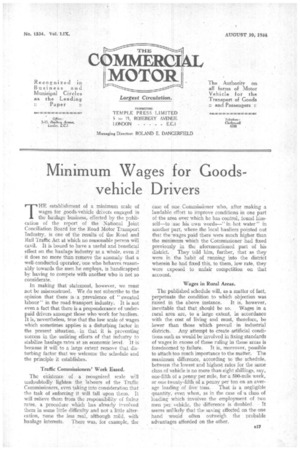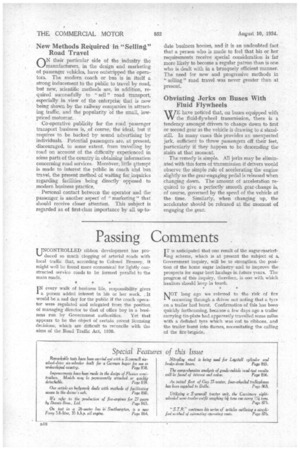Minimum Wages for Goods vehicle Drivers
Page 27

Page 28

If you've noticed an error in this article please click here to report it so we can fix it.
THE establishment of a minimum scale of wages for goods-vehicle drivers engaged in the haulage business, effected by the publication of the report of the National Joint Conciliation Board for the Road Motor Transport Industry, is one of the results of the Road and Rail Traffic Act at which no reasonable person will cavil. It is bound to have a useful and beneficial effect on the haulage industry as a whole, even if it does no MOTO than remove the anomaly that a well-conducted operator, one who behaves reasonably towards the men he employs, is handicapped by having to compete with another who is not so considerate.
In making that statement, however, we must not be misconstrued. We do not subscribe to the opinion that there is a prevalence of "sweated labour" in the road-transport industry_ It is not even a fact that there is a preponderance of underpaid drivers amongst those who work for hauliers. It is,•nevertheless, true that the low scale of wages which sometimes applies is a disturbing factor in the present situation, in that it is preventing success in the untiring efforts of that industry to stabilize haulage rates at an economic level. It is because it will to a large extent remove that disturbing factor that we welcome the schedule and the principle it establishes.
Traffic Commissioners' Work Eased.
The existence of a recognized scale will undoubtedly lighten the labours of the Traffic Commissioners, even taking into consideration that the task of enforcing it will fall upon them. It will relieve them from the responsibility of fixing rates, a procedure which has already involved them in some little difficulty and not a little altercation, none the less real, although mild, with haulage interests. There was, for example, the case of one Commissioner who, after making a laudable effort to improve conditions in one part of the area over which he has control, found himself—to use his own words-in hot water" in another part, where the local hauliers pointed out that the wages paid there were much higher than the minimum which the Commissioner had fixed previously in the aforementioned part of his district. They told him, further, that as they were in the habit of running into the district wherein he had fixed this, to them, low rate, they Were exposed to unfair competition on that account.
Wages in Rural Areas.
The published schedule will, as a matter of fact, perpetuate the condition to which objection was raised in the above instance. It is, however, inevitable that that shouId be so. Wages in a rural area are, to a large extent, in accordance with the cost of living and must, therefore, be lower than those which prevail in industrial districts. Any attempt to create artificial conditions such as would be involved in fixing standards of wages in excess of those ruling in those areas is foredoomed to failure. It is, moreover, possible to attach too much importance to the matter. The maximum difference, according to the schedule, between the lowest and highest rates for the same class of vehicle is no more than eight shillings, say, one-fifth of a penny per mile, for a 500-mile week, or one twenty-fifth of a penny per ton on an aver age loading .of fivetons. That is a negligible quantity, even when, as in the case of a class of loading which involves the employment of two men per, vehicle, the difference is doubled. It seems unlikely that the saving effected on the one hand would often outweigh the Probable advantages afforded on the other,
New Methods Required in "Selling" Road Travel
Otheir particular side of the industry the \.../manufacturers, in the design and marketing of passenger vehicles, have outstripped the operators. The modern coach or bus is in itself a strong inducement to the public to travel by road, but new, scientific methods are, in addition, required successfully to " sell " road transport, especially in view of the enterprise that is now being shown by the railway companies in attracting traffic, and the popularity of the small, lowpriced motorcar..
Co-operative publicity for the road passenger transport business is, of course, the ideal, hut it requires to be backed by sound advertising by individuals. Potential passengers are, at present, discouraged, to some extent, from travelling by road on account of the difficulty experienced in sOme parts of the country in obtaining information concerning road services. Moreover, little ttempt is made to interest the public in coach and bus travel, the present method of waiting for inquiries regarding facilities being directly opposed to modern business practice.
Personal contact between the operator and the passenger is another aspect of " marketing " that should receive closer attention. This subject is regarded as of first-class importance by all up-to date business houses, and it is an undoubted fact that a person who is made to feel that his or her requirements receive special consideration is far more likely to become a regular patron than is one who is dealt with in a brusquely efficient manner. The need for new and progressive methods in " selling " road travel was never greater than at present.
Obviating Jerks on Buses With Fluid Flywheels
have noticed that, on buses equipped with the fluid-flywheel transmission, there is a tendency amongst drivers to change down to first or second gear as the vehicle is drawing to a standstill. In many cases this provides an unexpected jerk, sufficient to throw passengers off their feet, particularly if they happen to be descending the stairs at that moment.
The remedy is simple. All jerks may be eliminated with this form of transmission if drivers would observe the simple rule of accelerating the engine slightly as the gear-engaging pedal is released when changing down. The amount of acceleration required to give a perfectly smooth gear-change is, of course, governed by the speed of the vehicle at the time. Similarly, when changing up, the accelerator should be released at the moment of engaging the gear.




















































































